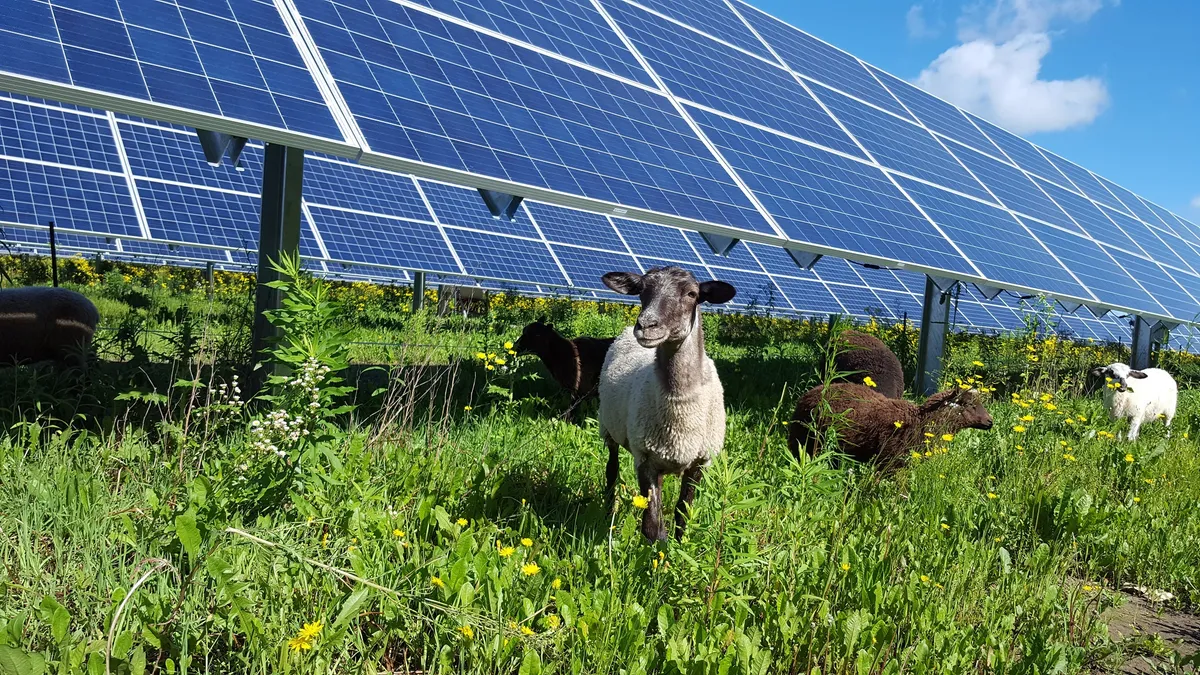As the U.S. solar industry expands, arrays are spreading across more land — and the cost of keeping the sun on those panels through vegetation management is rising. A one-shot solution to both the land-use and cost challenges is emerging: agrivoltaics. The term covers dual-use projects that co-locate agriculture and photovoltaic panels, and often reduce O&M costs in the process.
Solar energy panels are expected to cover 3 million acres in the U.S. by 2030 and 6 million by 2050, according to the National Renewable Energy Laboratory (NREL). "Solar developers want to develop on land, and farmers want to use their land to make money, but there's a lot of pushback in many rural areas because the landscapes are transforming and looking different," said Jordan Macknick, lead energy-water-land analyst for NREL. "There's going to be a large amount of solar development in every state. If this development is not done well or properly, we could see a loss in productivity of farmland."
Developers have responded to the community-acceptance and cost-savings pressures by piloting agrivoltaics projects in the Northeast, Southeast, Midwest and West, often using sheep, and utilities are taking notice. Costs of grazing livestock to manage vegetation growth can often run 30% less than traditional landscape maintenance, according to Lexie Hain, co-founder of the American Solar Grazing Association (ASGA).
ASGA was founded in New York three years ago and now counts nearly 100 members in about 30 states. Most are sheep producers or solar industry representatives, but the trade and advocacy group is currently considering a membership collaboration with a targeted goat grazing business as well. While sheep are considered the gold star for solar because they don't jump on panels, goats have long been used for utility and pipeline maintenance and perimeter maintenance (or maintaining vegetation around the borders of a site) in countries like France.
Sustainability is a factor, but cost savings is often the first driver that brings developers and utilities toward grazing, Hain said. "I was talking to one of the largest utilities in the world and they were starting to tell me how much of their O&M budget is just eaten up by paying landscapers," she said. "I could see they were astonished by how much money they were spending to just keep the sun on their panels."
Grazing livestock can run roughly $250-750 per acre per year, according to the ASGA, depending on region, topography and size (and excluding perimeter maintenance). Shepherds typically bring sheep to arrays for seasonal stretches and manage their grazing areas within the sites using movable fencing. Providing habitat for honey-producing bees and other pollinators on solar sites is another form of agrivoltaics, and livestock can graze on the same sites that provide pollinator habitat as well.
Saving money
The cost savings impressed Tampa Electric (TECO) when the utility put its solar O&M out to bid in 2018. Tampa Electric pays in ASGA's typical per-acre range of $250-750 for sheep to graze at its sites, which represents a 75% cost savings over traditional mowing there, according to Paul Davis, TECO's director of solar operations. A+ Environmental Restorations initially placed sheep on a couple of the utility's solar sites and has now expanded to eight of TECO's 12 solar locations. Nearly 5,000 acres now host sheep, with another 1,000 acres soon to add them.
Occasional challenges have cropped up, including one special to TECO. Because of the hot and humid Florida climate, Katahdin sheep are used to graze there. The breed has short hair rather than wool, and the utility found that sheep hair clogged intake pipes where sheep rubbed against them. TECO erected some basic hog fencing to keep sheep away from the pipes and solve the problem, Davis said.
TECO also voluntarily spent some extra money on predation barriers, putting down a nearly 3-foot "predator apron" along the ground at the edge of the 7-foot fence so animals like coyotes, foxes, and even raccoons couldn't dig underneath and threaten lambs. Davis described the investment as "more than a few thousand," but added: "In the overall scale of how much money we're spending on the whole site, it's pretty small."
TECO's 75% cost savings is exceptionally high, but the utility's upfront investment in quality fences and seed mixes, as well as its plan to allow wells for graziers' use, would allow a contractor to save money (and thus charge less) there, Hain said.
A strong working relationship with a contractor, like TECO has with A+ is vital, Davis added. "It needs to be a symbiotic relationship where they're doing their best to meet the challenges the sheep provide," he said. "We may need to spend a little bit of money to keep it viable to them."
Sometimes the cost savings is much less, but still considered worthwhile. Enel Green Power began grazing sheep as a pilot on its 150 MW Aurora project in Minnesota in 2018. The pilot went so well that it has moved to a full-on O&M program, with more than 4,000 sheep now grazing nearly 400 total acres across six sites. While the cost savings have been "modest," Enel also counts a decrease in fire risk and mower-damage risk as added benefits, said Marcus Krembs, head of sustainability for Enel North America.
Enel is also working with NREL to study the prevalence of pollinator insects on and around its sites. They hope that the research will demonstrate greater crop yields in pollinator-dependent crops like soybean and apples on farmers' land adjacent to solar sites. Preliminary results have been promising. That could increase local awareness and appreciation for what Krembs called the "ecosystem services" that well-developed solar can provide. "This is creating shared value," he said.
Winning project acceptance
Along with cost savings, increasing sustainability and building community support were the attractions for solar developer Nexamp to try grazing sheep, according to co-founder Will Thompson. Thompson also serves as senior vice president of its wholly owned subsidiary Nexamp Asset Management Services, overseeing ongoing O&M.
Among its 150 solar sites, Nexamp owns some projects and operates others for third-party customers in the Northeast as well as Georgia and California. For one 16-acre Massachusetts site built along a rocky ledge, Nexamp turned to Saladino Property Maintenance, a landscaping company with farming experience.
The cost savings across the sites it grazes average 19% over mowing, but at that ledged site, they came out to 38%, Thompson said, translating to tens of thousands of dollars in savings a year. "It otherwise would've had to be hand-maintained over several acres that would've completely blown the O&M budget, whereas with sheep it was less than or equal to the cost of maintaining a regular site," he said.
Nexamp is developing projects in Pennsylvania, Maine, Minnesota, New Jersey and Illinois, and anticipates taking over a utility-scale project in North Carolina later this year. Dual-use sites that incorporate agriculture are a competitive advantage, and in some cases a requirement, the company is finding.
"We are seeing that municipalities are increasingly asking for dual use," Thompson said. "Our first utility-scale project is going to require dual use. If we weren't able to tout that, we likely would not have been selected. If we can go to a municipality and say we are a better community partner, it's a win-win-win."
Challenges to scaling
Nexamp currently uses solar grazing on six of its 150 project sites. That's "not a heavy lift," Thompson acknowledged — but the developer has found the key challenge to scaling up is finding local shepherds. "It's more that the [grazing] industry needs to catch up and generate interest among other people who want to get into it," he said. "There just aren't enough people in this business."
Tucson Electric Power (TEP) has run into a classic ranching challenge with grazers: successfully keeping predators away from them out West. TEP began thinking about agrivoltaics in 2013, after hearing about the concept at a Smart Electric Power Alliance conference, renewable energy project manager Ericca Suarez said.
A Power Purchase Agreement (PPA) holder was grazing sheep at Red Horse, a 500-plus-acre, 70 MW solar site that was holder-owned. TEP was impressed by how well the arrangement worked, and brought 30 sheep to one of its own sites in 2018. They lasted one year.
At the Red Horse site, there was one Great Pyrenees dog for every 30 sheep. TEP's site involved an easement with Pima County, as well as a battery storage device that needed access. Dogs created too much of a liability, but without them, coyotes kept getting to the lambs. Both the shepherd and the utility broke even for the year, but discontinued the grazing there. "As much as we wanted to get dogs there, people needed access regularly. It was too much of a [safety] risk," Suarez said. "If we do do this again it'll have to be our own site, without any extras."
TEP is currently building a 100-acre, 15 MW solar site that the utility will own outright when it comes online in the next few years. Grazing livestock there is "a five-year plan at this point," Suarez said. "But we're definitely still considering using sheep."
In California, agrivoltaics has presented different challenges, according to Amanda Beck, project development manager for the Power Generation Group at the Sacramento Municipal Utility District (SMUD). Beck previously worked for a solar developer on the Topaz Project, a 550 MW site in the Central Valley.
Sheep were brought in to graze that site. The developer loved the agricultural element of the project in the dry-farmland area. The operations manager found that cables had to be protected by trays s so the sheep wouldn't bother the wiring, Beck said. But on a practical level, the sheep reduced the risks mowers present, including wildfire risk from sparks and regular damages to panels from kicked-up rocks.
Now, with Beck's help, SMUD hopes to have sheep graze its 523-acre Rancho Seco II, a 160 MW solar project expected to be online by end of 2020. SMUD developed the project and has a PPA with DE Shaw Renewables. DE Shaw is building the facility and will operate it by contract. But SMUD is encouraging the company to use grazing for the long-term vegetation management, and having the site set up with grazing-friendly features like water access and minimized grading.
The site adjustments are minimal compared to the advantages, Beck said. "There are trade-offs with everything you do," she said. "In this case, while you had some issues with cable trays, the benefits outweigh the negatives, so there's just no reason not to do it."





















